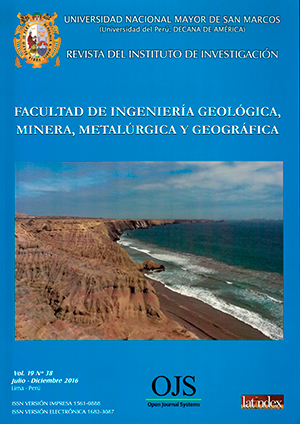Evaluation of the bacterial load and antibiotic resistance of isolated of marine bacteria in marine areas of high influence of larval production in Ecuador
DOI:
https://doi.org/10.15381/iigeo.v19i38.13580Keywords:
Bacterial loads, antimicrobial activity, Larviculture, Microbiology, BiochemistryAbstract
Given the continuing incidence of mortality occurred in the larval cultures Mar Bravo, it was considered appropriate to remove information from bacterial loads of the study area of water samples of shrimp laboratories, open sea, downloads tanks crops and downloads treated . The samplings were conducted at both stations both in the dry season and the rainy season. Water samples were seeded in Vibrio TCBS agar and TSA, for quantification, and subsequent tests to measure their restinceia antibiogram antibiotic and biochemical identification using the miniaturized method (Solis, 1996). Microbiological analyzes allowed to know the ufc.ml. in the points analyzed, and the presence of luminescence in the bacterial strains associated with response factor qourum sense, communication between pathogenic bacteria and possible death of domesticated animals. The biochemical characterization of bacterial strains allowed 132 determined according to seasonal superior compatibility to 65% by the method of identification used by miniaturized Solis (1996), there is a presence of 38% V. parahaemolyticus; V. alginolyticus followed by 21%; V. damsela V. harveyi with 6%; V. I. splendidus with 5%; V. nereis, V. fischeri, V. anguillarum with 3% each; V. vulnificus, V. tubiashi, V. splendidus II, V. marinus, V. cholerae, V. campbelli with 2% correspondingly; and the body lower prevalence was V. logei with 1%. For resistant strains were found in 26% susceptibility testing; responded to genres tubiashii and Vibrio Cholera Vibrio, other strains showed percentages reported lower resistance. This comparison enabled us to determine whether the larval production negatively impacts on the environment or are seasonal conditions which produce a bacterial variability by modifying existing bacterial genera, causing losses mortalities in cropping systems and changes in the marine environment The Macroscopic Characteristics of the strains mostly found, reported that diplococos and coconuts are at a higher percentage than 40%, morphologies of streptococcus in a (9.1%) being the tetracocos the lowest prevalence (5.1%), some of these macroscopic features are absent in some samples and re appear in other, which indicates that seasonality influences the bacterial morphology
Downloads
Published
Issue
Section
License
Copyright (c) 2016 Sonya Mendoza S., Tinoco Gómez O., Nieto K.

This work is licensed under a Creative Commons Attribution-NonCommercial-ShareAlike 4.0 International License.
AUTHORS RETAIN THEIR RIGHTS:
a. Authors retain their trade mark rights and patent, and also on any process or procedure described in the article.
b. Authors retain their right to share, copy, distribute, perform and publicly communicate their article (eg, to place their article in an institutional repository or publish it in a book), with an acknowledgment of its initial publication in the Rev. Inst. investig. Fac. minas metal cienc. geogr.
c. Authors retain theirs right to make a subsequent publication of their work, to use the article or any part thereof (eg a compilation of his papers, lecture notes, thesis, or a book), always indicating the source of publication (the originator of the work, journal, volume, number and date).























